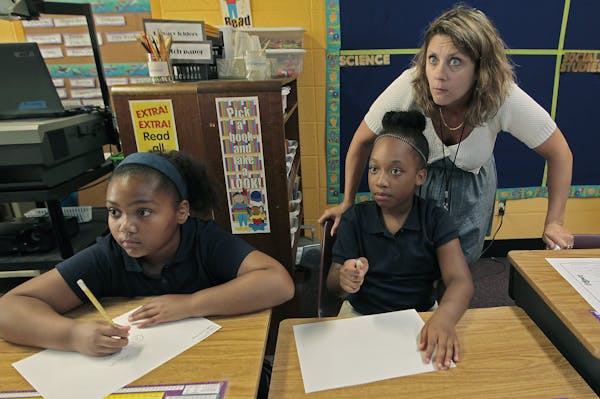Lucy Craft Laney Community School Principal Mauri Melander always braces for the release of the annual standardized testing numbers.
This year, they revealed a low point that was hard to ignore: Not a single seventh-grader at the school met state math standards last year.
Out of 33 students tested in that grade, 23 did not meet standards and 10 only partly met standards, according to state testing data released last week.
Melander said improvement takes time and there are more than a few early signs of hope. The district has bolstered classroom instruction and the test scores were not all bad. Third- to sixth-grade math scores had all improved.
But Lucy Laney had among the lowest overall test results in the state, underscoring the ongoing challenges facing an inner-city school where administrators face a relentless turnover of teachers and draw a high population of children who are homeless or have unstable housing.
Melander said the community has every right to be concerned.
"The lowlight that popped out to me right away was my seventh-grade math results," Melander said. Those students, she said, "have struggled on their math scores every year."
For more than a decade, a strong majority of students at Lucy Laney have been far below state and federal education standards. The school, located in Minneapolis' Cleveland neighborhood, has become the center of numerous district initiatives that aim to increase achievement and close a stubborn and profound academic achievement gap between white and minority students.
The school's website features pictures of visits by Minneapolis Police Chief Janeé Harteau and Minnesota Supreme Court Justice Alan Page, who spoke to eighth-graders last spring about the importance of education and succeeding in life.
In 2012, Vikings vice president Kevin Warren, the highest-ranking black business executive with an NFL team, and his wife, Greta, donated 650 backpacks filled with school supplies to Lucy Laney students.
But overall, students continue to lag badly academically. Of the 300 students who were tested, just 13 percent were proficient in math and 8 percent met reading standards last year.
High teacher turnover
Melander, who has been the principal for three years, said there are many reasons for the poor results.
The challenging classroom environment has resulted in some of the highest teacher turnover rates in the district. That often means the school is filled with first-year teachers, Melander said. Those fresh teachers are often brimming with enthusiasm, but lack the experience and seasoned teaching skills necessary for struggling students. Last year, for instance, Melander had 17 first-year teachers, a low number compared to past years.
"August is always my favorite time of year because my teachers are always so optimistic. Their goals are always aspirational," Melander said.
Each fall students are given a test to determine a baseline for the year. Melander said most students are two to three years below grade level, and the gap widens as students get older.
"As soon as [teachers] start looking at their baseline data and as soon as they start seeing the day in and day out, they start to get a little discouraged," she said.
Roller coaster cheer
Melander places much of her hope in her veteran teachers, who can mentor the new ones.
Sigrid Espe, an eighth-grade algebra teacher, now teaches the group of children who did not meet math standards last year.
In her class of 12, Espe taught the students about order of operations, demonstrating how to solve a math problem. Then, it was time for the class to solve one on their own.
"Stand up when you have the answer," she told her students.
In less than 30 seconds, two students stood up, one wearing an "academic achiever" polo shirt. Espe circled the room, checking the progress of each child. In about three minutes, six students stood.
And when two students modeled their work to the class, Espe made sure to recognize them for their effort and success.
They chose from three different cheers, dubbed a roller coaster cheer, a fantastic cheer and an avid cheer. Cheers made up of wooing sounds and hand clapping came from every other student in the classroom.
Both went back to their desks, with bashful smiles as their peers cheered.
Success in co-teaching
Melander said she expects to start seeing tangible gains once a new teaching model is fully implemented this year that adds a second instructor to certain classrooms.
Every kindergarten through fifth-grade classroom teacher now has a specialized math and literacy instructor joining them.
After seeing math proficiency drop to 1.4 percent for fifth-graders in 2011, the district placed a specialized math instructor in each fifth-grade classroom.
Every year since, Lucy Laney students have seen increases in fifth-grade math scores. This year, 16.4 percent of students were proficient, the highest since 2010.
Other grade levels at Lucy Laney saw gains in math, as well. Sixth-grade math went from 2.4 percent to 10.2 percent meeting standards.
Melander is well aware that a majority of students are still lagging badly.
"I don't shy away from accountability," Melander said. "Where I use it to my advantage is I turn it right back around. I will not let people forget what I am trying to accomplish in this building. I believe strongly that if you want something different, you have to do something drastic."
Alejandra Matos • 612-673-4028

The story of Hercules the cat: Rescued in 2022, Target model in 2024

Minnesota State Patrol celebrates diverse new class of troopers

